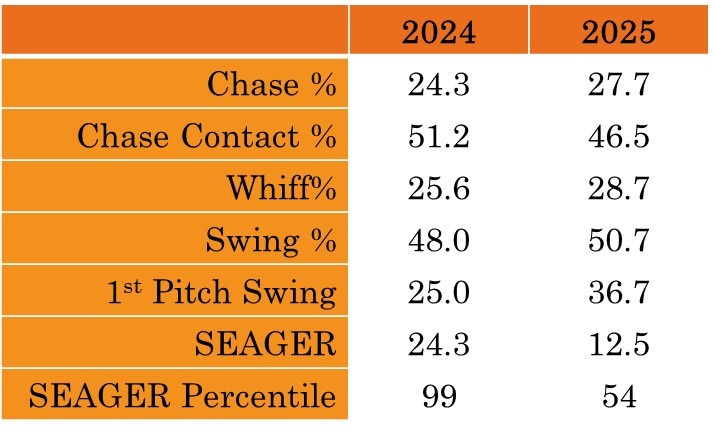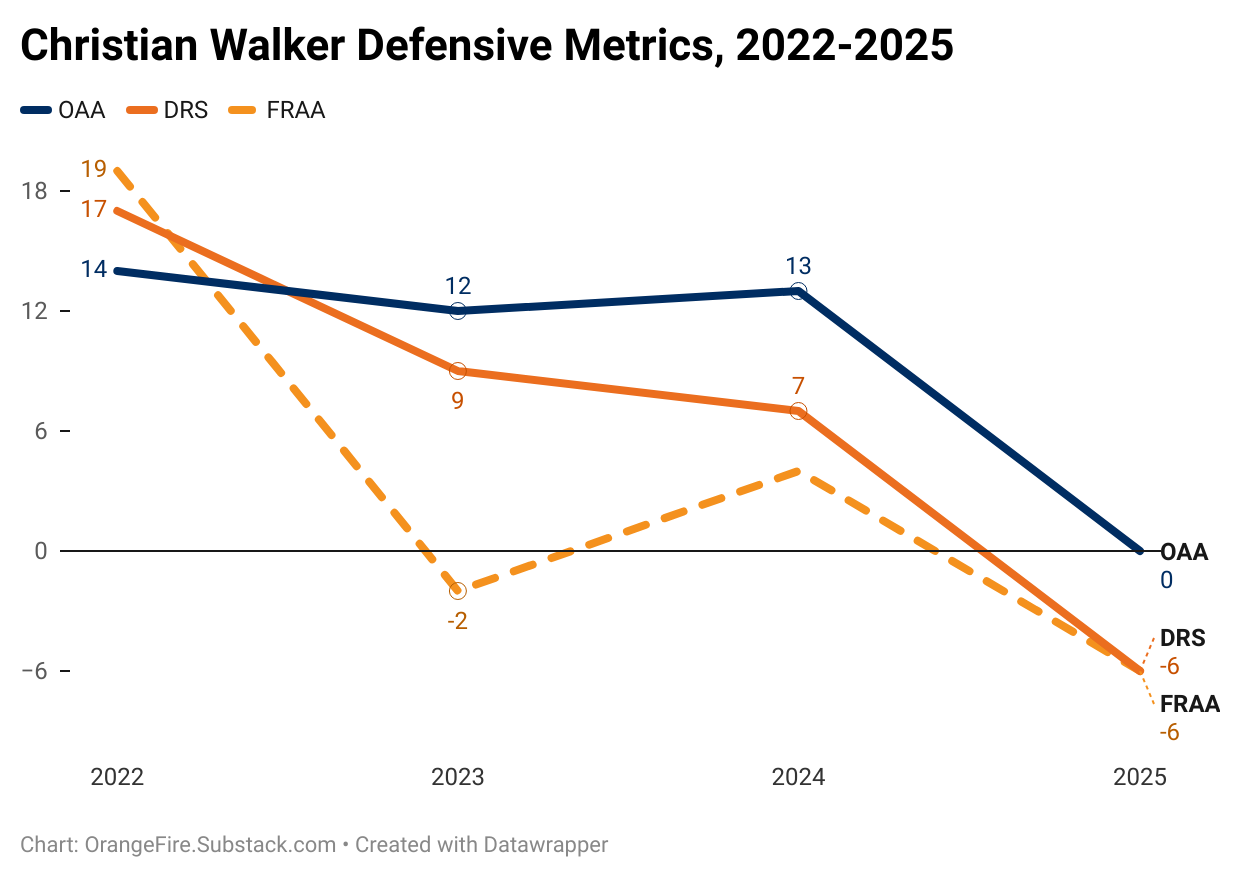Is Christian Walker Washed?
He's walking less, striking out more, chasing more pitches, swinging more at first pitches, and his defensive numbers are down. It's a picture of a player in decline.
You probably thought happy thoughts when the Astros signed Christian Walker back in December. The Astros had addressed a big hole at first base with one of the best free agents on the market.
And you had a lot of company. Writing at The Athletic, Chandler Rome said that “Walker should provide stability” at first base thanks to his “above-average power at the plate and elite ability in the field.”1
At Baseball Prospectus, Timothy Jackson argued that signing Walker was different from when the Astros had signed Jose Abreu because “Walker isn’t coming off two uncharacteristic seasons in which he was notably different in one way or another. He still hits the everloving hell out of the ball.
Michael Baumann of Fangraphs was the most effusive, calling it a “great deal for Houston” because Walker was two years younger than Abreu when signed and because “Walker’s the better athlete.”
Jim Bowden of The Athletic summed up the consensus when he reviewed the Astros offseason when he called signing Walker the team’s “best move.”
As you know that consensus was wrong. So far in 2025, Walker has slashed .213/.278/.357. That has produced a weighted Run Created plus (wRC+) of 79. That is a measure of total offensive production scaled so that 100 is league average. And Walker’s 79 means that he’s hitting 21% worse than the league average hitter.
The Captain Obvious take is right here: this has not gone well.
The question I examine today is will this slump from Christian Walker—which has lasted for half of the season—continue. Walker was a remarkably consistent player over his final 3 years in Arizona; his wRC+ was between 119 and 122 each of those years and he won a Gold Glove each of those seasons. Will Walker get back to the player he was in those seasons?
I examine several different types of data on Walker’s performance this year, comparing it to his past. My conclusion is not promising. There is clear evidence that Walker has declined as a player this season. He’s performing worse not because he’s hitting in bad luck or just going through a slump. His skills as a player—both at the plate and in the field—seem to have declined. I’m pessimistic that Walker will return to the player described in those analyses written right after Walker signed with the Astros.
Walk and Strikeout Rates Going in the Wrong Direction
What do good hitters do? They let balls outside of the strike zone go so they can take a walk. And they make contact when the do swing, avoiding strikeouts. Over most of his career, especially over the past few seasons, Christian Walker has done that. Until this season.
The two graphs below show Walker’s walk and strikeout rates since he became a regular in the 2019 season. For comparison, I included the major league average. Walker bounced up and down in his first few seasons as the D-Backs starting first baseman, especially in the COVID shortened 2020 season. But over his last 3 seasons in the desert, he improved to have a well above average walk rate. He also has a well below average strikeout rate in 2022 and 2023.
The graph allows one to see Walker’s regression in 2025. He’s gone from an above average walk rate to a below average one, walking in only 6.9% of his plate appearances. His strikeout rate—which went up in 2024—went up even more in 2025. Walker has struck out in 27.8% of his plate appearances this season, well above the league average of 21.9%. How far above average is Walker’s strikeout rate? He as the 14th highest K rate among qualified major league hitters this season.
In an offseason, Walker went from a player with above average plate discipline, to one with below average plate discipline.
Worse Swing Decisions
What is causing Walker’s increase in strikeouts and decrease in walks? I looked further into measures of the swing decisions that Walker is making at the plate.
The table below shows these metrics with Walker’s numbers from 2024 in the center column and his 2025 numbers on the right. The chart shows that Walker is chasing more pitches in 2025 and that he is making contact less often this season when he does swing at pitches outside of the strike zone. Put them together, and Walker’s whiff% has increased; in 2025, he whiffed 25.6% of the time he swung the bat. This season, he’s whiffing on 28.7% of his swings.
Walker is taking fewer walks because he’s not taking enough balls. And he’s striking out more because when he does chase, he’s more likely to swing-and-miss. All of these numbers are moving in the wrong direction.
What stands out most to me is Walker’s increase in swinging at the first pitch. He swung at 25.0% of first pitches in 2024; this year, he’s up to 36.7%
My educated guess is that Walker is swinging at the first pitch more often this season because he knows his skills are deteriorating. He can’t make as much contact as he would like, so he’s cheating a little bit. If the first pitch is near the plate, he’s more willing to swing at it. He doesn’t think he can succeed later in an at bat.
Overall, the result is that Walker is making worse swing decisions in 2025. One way to see this is in the SEAGER measure, created by Robert Orr at Baseball Prospectus. Seager stands for SElective AGgression Engagement Rate and tries to measure how often a player swings at hittable pitches and takes unhittable pitches. Rather than just noting when a batter lets a ball go (i.e. chase rate), it also takes into account whether a player aggressively swings at balls in strike zone he can drive.
Walker’s SEAGER score declined from 24.3 in 2024 to 12.5 in 2025. What does that mean? In 2024, Walker was at the 99th percentile in this measure, meaning he was making swing decisions at an elite rate. This season, he’s much closer to league average.
Walker’s swing decisions have declined this year. He’s chasing more pitches out of the strike zone and missing on more of his swings. As a result, he’s walking less, striking out more, and is a lot less productive at the plate. Worse decisions have led to worse results.

Declining Defense
Walker’s decline in skills is not limited to the plate. He has also declined in the field as well.
Walker has excellent defensive numbers across his career. He won Gold Gloves in the 2022, 2023, and 2024 seasons, and deservedly so. In 2022 and 2023, he led National League first basemen in Defensive Runs Saved. In 2024, he was second among senior circuit first sackers.
But this year, his numbers have declined significantly at first base. He has been worth -6 Defensive Runs Saved.
Defensive metrics are notoriously finicky, so one may wonder if those number are the product of that particular metric. The graph below shows Walker’s defensive numbers for three different metrics—Defensive Runs Saved (DRS), Outs Above Average (OAA), and Fielding Runs Above Average (FRAA).
All three tell the exact same story. Walker has significantly declined defensively this season at first base. He’s a neutral player in OAA and a negative one in DRS and FRAA.
Statcast divides up a first baseman’s defensive abilities by measuring how he does moving laterally to his right and laterally to his left. In 2024, Walker recorded 5 Outs Above Average moving to his left. This year, he’s at -2. In 2024, Walker recorded 4 Outs Above Average moving to his right. This year, he’s at -1. In short, Walker has much less range at first base than he did even last season.
Don’t Sign Anyone Over 30
The combination of offensive decline and defensive decline from Walker seems to indicate an overall deterioration in his athletic abilities. Which is a fancy way of saying he’s getting older and older players decline.
This is of course true for every human, and is especially true for professional athletes, who must be at the peak of their physical prowess to compete against other high-level athletes. And on average, baseball players decline in and across their 30s, each individual player declines on his own timetable.
Walker’s decline seems to be quite sudden. Reading the evaluations of the Walker signing back in December shows no signs that smart baseball people thought Walker was a player in decline.2 He seemed consistent and had retained his athleticism.
Until he didn’t, starting on Opening Day of the 2025 season. He’s been a poor performing player this season and my study here indicates that is because his skills are declining. He’s demonstrably worse in his baseball talents than he was in the 2024 season.
This is the risk of signing free agents. The rules established by the Collective Bargaining Agreement says that teams control the rights of players through their first six seasons in the majors. That control gives teams leverage to pay players below their market value during those six seasons. We have also seen a rise in “service time manipulation” in the past decade and a half, which are tactics teams use to gain extra time from their players before they become free agents.
As a result, free agents are older players and thus, most likely to be on the wrong side of the aging curve for baseball players. The Astros have now been burned twice in a row signing a well-respected first baseman to a three-year deal through their mid to late 30s.
The lesson from a front office perspective is that free agent signings are inherently risky because you are locking in an aging player. In the ideal world, teams would never need to sign a free agent because their farm system is constantly producing high-quality young and cost-controlled players.
The Astros came close to that ideal from 2012 through 2022, producing the core of a World Series winner in 2017 then replacing that core with a new one that won another title in 2022. Even with that, the farm system could not cover every position on the team.
In particular, the farm system failed to produce a quality first baseman, and the team has struggled to replace Yuli Gurriel ever since he entered his decline phase in the 2022 season. In the ideal, the team would develop a prospect to play first base over the next several seasons. But for whatever reason, the Astros have not been able to do so.
And for whatever reason, the front office has now twice tried to plug that hole with a free agent first baseman, and has not been able to anticipate that player’s rapid aging.
In a season in which the Astros have outpaced expectations and developed a solid lead in the AL West, the Walker signing has been a clear negative for the team. Unfortunately, it looks like that will not reverse itself.
Technically, that article is co-written by Ken Rosenthal, Rome, and Noah Furtado. But the sentence after “should provide stability” says “the Astros extracted minus-1,4 wins above replacement from their first baseman.” That’s definitely vintage Chandler wording, so I’m giving him full credit for what I quoted.
You could find these concerns when the Astros signed Jose Abreu in December 2022.




